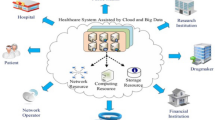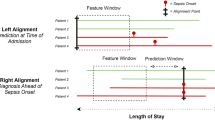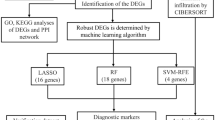Abstract
Clinical pathways’ variances present complex, fuzzy, uncertain and high-risk characteristics. They could cause complicating diseases or even endanger patients’ life if not handled effectively. In order to improve the accuracy and efficiency of variances handling by Takagi-Sugeno (T-S) fuzzy neural networks (FNNs), a new variances handling method for clinical pathways (CPs) is proposed in this study, which is based on T-S FNNs with novel hybrid learning algorithm. And the optimal structure and parameters can be achieved simultaneously by integrating the random cooperative decomposing particle swarm optimization algorithm (RCDPSO) and discrete binary version of PSO (DPSO) algorithm. Finally, a case study on liver poisoning of osteosarcoma preoperative chemotherapy CP is used to validate the proposed method. The result demonstrates that T-S FNNs based on the proposed algorithm achieves superior performances in efficiency, precision, and generalization ability to standard T-S FNNs, Mamdani FNNs and T-S FNNs based on other algorithms (CPSO and PSO) for variances handling of CPs.










Similar content being viewed by others
References
Bragato, L., and Jacobs, K., Care pathways: the road to better health services. J. Health Organ. Manage. 17(3):164–180, 2003.
Cheah, J., Development and implementation of a clinical pathway programme in an acute care general hospital in Singapore. Int. J. Qual. Health Care 12:403–412, 2000.
Hunter, B., and Segrott, J., Re-mapping client journeys and professional identities: a review of the literature on clinical pathways. Int. J. Nurs. Stud. 45(4):608–625, 2008.
Wakamiya, S. J., and Yamauchi, K., What are the standard functions of electronic clinical pathways? Int. J. Med. Inform. 78(8):543–550, 2009.
Du, G., Jiang, Z. B., Diao, X. D., Ye, Y., Yao, Y., Modeling, variation monitoring, analyzing, reasoning for intelligently reconfigurable clinical pathway. Proceedings of the IEEE International Conference on Service Operations, Logistics and Informatics, 85–90, Chicago, IL, USA, 2009.
Wigfield, A., and Boon, E., Critical care pathway development: the way forward. Br. J. Nurs. 5(12):732–735, 1996.
Cheah, J., Clinical pathways: changing the face of client care delivery in the next millennium. Clinician Manag. 7(78):78–84, 1998.
Price, M. B., Jones, A., Hawkins, J. A., et al., Critical pathways for postoperative care after simple congenital heart surgery. AJMC 5:185–192, 1999.
Atwal, A., and Caldwell, K., Do multidisciplinary integrated care pathways improve interprofessional collaboration? Scand. J. Caring Sci. 16(4):360–367, 2002.
Bryan, S., Holmes, S., Prostlethwaite, D., and Carty, N., The role of integrated care pathways in improving the client experience. Prof. Nurse 18(2):77–79, 2002.
Caminiti, C., Scoditti, U., Diodati, F., and Passalacqua, R., How to promote, improve and test adherence to scientific evidence in clinical practice. BMC Health Serv. Res. 5(62):1–11, 2005.
Wakamiya, S., and Yamauchi, K., A new approach to systematization of the management of paper-based clinical pathways. Comput. Meth. Programs Biomed. 82:169–176, 2006.
Ye, Y., Jiang, Z. B., Diao, X. D., Yang, D., and Du, G., An ontology-based hierarchical semantic modeling approach to clinical pathway workflows. Comput. Biol. Med. 39(8):722–732, 2009.
Ye, Y., Jiang, Z. B., Diao, X. D., Du, G., Knowledge-based hybrid variance handling for patient care workflows based on clinical pathways. Proceedings of the IEEE International Conference on Service Operations, Logistics and Informatics, 13–18, Chicago, IL, USA, 2009.
Ye, Y., Jiang, Z. B., Diao, X. D., Du, G., A Semantics-Based Clinical Pathway Workflow and Variance Management Framework, 2008 IEEE International Conference on Service Operations and Logistics, and Informatics, 758–762, Bei Jing, China, 2008.
Du, G., Jiang, Z. B., Diao, X. D., Sun, Y. J., Ye, Y., and Yao, Y., Adaptive workflow engine based on rule for clinical pathway. Journal of Shanghai Jiao Tong University 43(7):1021–1026, 2009.
Er, O., Yumusak, N., and Temurtas, F., Chest diseases diagnosis using artificial neural networks. Expert Syst. Appl. 37(12):7648–7655, 2010.
Chen, Y., Yang, B., Abraham, A., and Peng, L., Automatic design of hierarchical Takagi–Sugeno fuzzy systems using evolutionary algorithms. IEEE Trans. Fuzzy Syst. 15(3):385–397, 2007.
Yoon, Y., Guimaraes, T., and Swales, G., Integrating artificial neural networks with rule-based expert systems. Decis. Support Syst. 11(5):497–507, 1994.
Takagi, T., and Sugeno, M., Fuzzy identification of systems and its applications to modeling and control. IEEE Trans. Syst. Man Cybern. 15:116–132, 1985.
Lin, F. J., Lin, C. H., and Shen, P. H., Self-constructing fuzzy neural network speed controller for permanent-magnet synchronous motor drive. IEEE Trans. Fuzzy Sys. 9(5):751–759, 2001.
Jang, J. S. R., ANFIS: Adaptive network based fuzzy inference system. IEEE Trans. Syst. Man Cybern. 23(3):665–684, 1993.
Pedrycz, W., and Reformat, M., Evolutionary fuzzy modeling. IEEE Trans. Fuzzy Syst. 11(5):652–665, 2003.
Oh, S. K., Pedrycz, W., and Park, H. S., Hybrid id entification in fuzzy neural networks. Fuzzy Sets Syst. 138:399–426, 2003.
Wang, L., and Yen, J., Extracting fuzzy rules for system modeling using a hybrid of genetic algorithms and Kalman filter. Fuzzy Sets Syst. 101:353–362, 1999.
Wang, H., Kwong, S., Jin, Y., Wei, W., and Man, K. F., Multi-objective hierarchical genetic algorithm for interpretable fuzzy rule-based knowledge extraction. Fuzzy Sets Syst. 149(1):149–186, 2005.
Tang, A. M., Quek, C., and Ng, G. S., GA-TSKfnn: parameters tuning of fuzzy neural network using genetic algorithms. Expert Syst. Appl. 29:769–781, 2005.
Lin, C. J., and Xu, Y. J., A self-adaptive neural fuzzy network with group-based symbiotic evolution and its prediction applications. Fuzzy Sets Syst. 157:1036–1056, 2006.
Jelodar, M. S., Kamal, M., Fakhraie, S. M., Ahmadabadi, M. N., SOPC-based parallel genetic algorithm. Proceedings of the IEEE Congress on Evolutionary Computation, Vancouver, BC, Canada, 2006.
Kennedy, J., Eberhart, R C., Particle swarm optimization. Proceedings of the IEEE International Conference on Neural Networks. Piscataway, 1942–1948, 1995.
Fourie, P. C., and Groenwold, A. A., The particle swarm optimization algorithm in size and shape. Struct. Multidiscip. O. 23(4):259–267, 2002.
Han, M., Sun, Y. N., and Fan, Y. N., An improved fuzzy neural network based on T-S model. Expert Syst. Appl. 34:2905–2920, 2008.
Khosla, A., Kumar, S., Aggarwal, K. K., A framework for identification of fuzzy models through particle swarm optimization, Proceedings of the IEEE Indicon Conference, 388–391, Chennai, India, 2005.
Khosla, A., Kumar, S., Ghosh, K. R., A comparison of computational efforts between particle swarm optimization and genetic algorithm for identification of fuzzy models, in: Annual Conference of the North American Fuzzy Information Processing Society-NAFIPS, 245–250, 2007.
Shoorehdeli, M. A., Teshnehlab, M., and Sedigh, A. K., Training ANFIS as an identifier with intelligent hybrid stable learning algorithm based on particle swarm optimization and extended Kalman filter. Expert Syst. Appl. 160:922–948, 2009.
Shi, Y., and Eberhart, R. C., Empirical study of particle swarm optimization. Proc. IEEE Int. Conf. Evolutionary Computation 3:101–106, 1999.
Ratnaweera, A., Halgamuge, S. K., and Watoson, H. C., Self-organizing hierarchical particle swarm optimizer with time-varying acceleration coefficient. IEEE Trans. Evol. Comput. 8(3):240–255, 2004.
Lovbjerg, M., Rasmussen, T. K., Krink, T., Hybrid particle swarm optimizer with breeding and sub-populations. Proceedings of the Genetic and Evolutionary Computation Conference (GECCO). San Francisco, CA, July 2001.
Xie, X. F., Zhang, W. J., et al., Optimizing semiconductor devices by self-organizing particle swarm. Congress on Evolutionary Computation, Oregon, USA, 2017–2022, 2004.
He, R., Wang, Y., et al., An improved particle swarm optimization based on self-adaptive escape velocity. JSW 16(12):2036–2044, 2005.
Lin, C.-J., Wang, J.-G., and Lee, C.-Y., Pattern recognition using neural-fuzzy networks based on improved particle swam optimization. Expert Syst. Appl. 36:5402–5410, 2009.
Lin, C.-J., An efficient immune-based symbiotic particle swarm optimization learning algorithm for TSK-type neuro-fuzzy networks design. Fuzzy Sets Syst. 159:2890–2909, 2008.
Van den Bergh, F., and Engelbrecht, A. P., A cooperative approach to particle swarm optimization. IEEE Trans. Evol. Comput. 8(3):225–239, 2004.
Niu, B., Zhu, Y. L., He, X. X., and Shena, H., A multi-swarm optimizer based fuzzy modeling approach for dynamic systems processing. Neurocomputing 71:1436–1448, 2008.
Higashi, N., Iba, H., Particle swarm optimization with Gaussian mutation. Proceedings of the IEEE Swarm Intelligence Symp. Indianapolis: IEEE Inc, 72–79, 2003.
Kennedy, J., Eberhart, R. C., A discrete binary version of the particle swarm algorithm, systems, man, and cybernetics, Computational Cybernetics and Simulation IEEE International Conference, 5 (12–15): 4104–4108, 1997.
Simon, D., Training fuzzy systems with the extended Kalman filter. Fuzzy Sets Syst. 132:189–199, 2002.
Coffin, M., and Saltzman, Statistical analysis of computational tests of algorithms and heuristics. INFORMS J. Comput. 12(1):24–44, 2000.
Acknowledgement
This work described in this paper was supported by Research Grant from National Natural Science Foundation of China (60774103) and Major Program Development Fund of SJTU. Moreover, we would also like to thank to the whole medical staff of Shanghai No. 6 People’s Hospital for real data collecting and helpful discussions.
The authors would like to express sincere appreciation to the journal editor and two anonymous referees for their detailed and helpful comments to improve the quality of the paper.
Author information
Authors and Affiliations
Corresponding author
Rights and permissions
About this article
Cite this article
Du, G., Jiang, Z., Diao, X. et al. Variances Handling Method of Clinical Pathways Based on T-S Fuzzy Neural Networks with Novel Hybrid Learning Algorithm. J Med Syst 36, 1283–1300 (2012). https://doi.org/10.1007/s10916-010-9589-6
Received:
Accepted:
Published:
Issue Date:
DOI: https://doi.org/10.1007/s10916-010-9589-6




